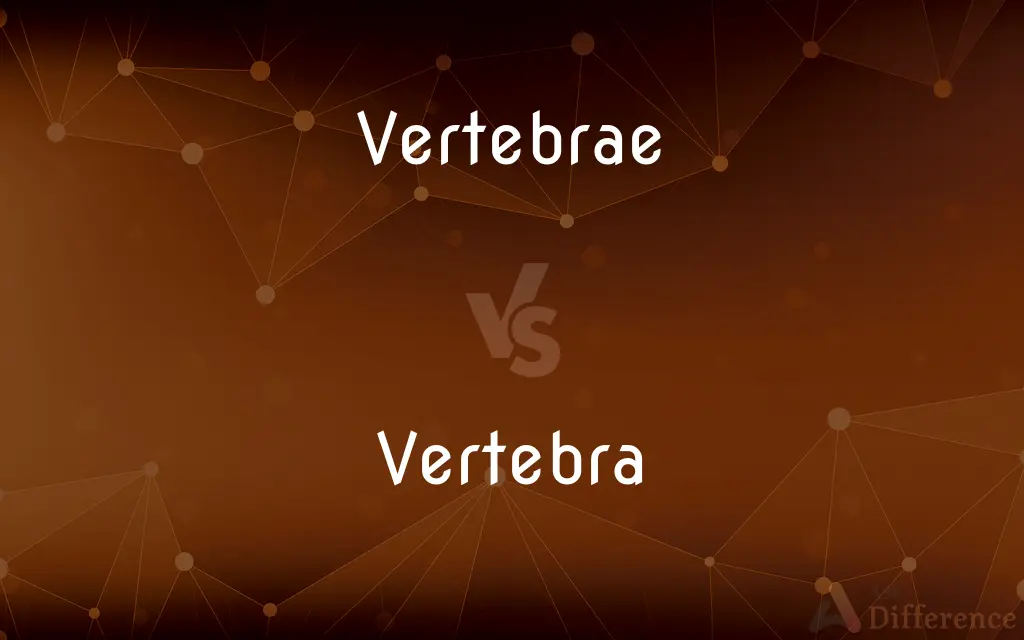Vertebrae vs. Vertebra — What's the Difference?
Edited by Tayyaba Rehman — By Fiza Rafique — Updated on October 30, 2023
"Vertebrae" is the plural form denoting multiple backbone segments, while "vertebra" is the singular form referring to a single segment.

Difference Between Vertebrae and Vertebra
Table of Contents
ADVERTISEMENT
Key Differences
"Vertebrae" and "vertebra" both relate to the bones that make up the spinal column in vertebrates, including humans. However, while they refer to the same anatomical structure, the distinction lies in the quantity. "Vertebrae" denotes more than one spinal bone, indicating the collective segments. On the other hand, "vertebra" signifies just one of those individual bones.
When discussing the backbone, one might say that the human spine consists of multiple "vertebrae," indicating all the bones from the cervical to the lumbar regions. Yet, if the conversation narrows down to a specific segment or bone of the spine, "vertebra" would be the appropriate term.
In anatomical studies, understanding the difference between "vertebrae" and "vertebra" is crucial. When students study the detailed structure or pathology of a single spinal bone, they'd be examining a "vertebra." In contrast, when referring to patterns, alignments, or curvatures involving several bones, they'd be discussing the "vertebrae."
Lastly, both "vertebrae" and "vertebra" are derived from Latin, where "vertebra" means joint or hinge. It's essential to use these terms correctly in both written and spoken English, especially in professional or medical contexts, to ensure clarity and precision.
Comparison Chart
Number
Plural
Singular
ADVERTISEMENT
Refers to
Multiple segments of the backbone
One segment of the backbone
Usage Context
Anatomy, when referring to multiple spinal bones
Anatomy, when referring to a single bone
Grammatical Category
Noun (plural)
Noun (singular)
Examples
"The lumbar vertebrae are in the lower back."
"The C1 vertebra is called the atlas."
Compare with Definitions
Vertebrae
The segments composing the backbone of vertebrates.
The vertebrae protect the spinal cord from injury.
Vertebra
One of the many bony segments in the spine.
An injury to a vertebra can be painful.
Vertebrae
The articulated series of bones held together by ligaments.
Some animals have more vertebrae than humans.
Vertebra
One of the articulated bones protecting the spinal cord.
Between each vertebra are intervertebral discs.
Vertebrae
The collective bones forming the spinal column.
Humans typically have 33 vertebrae at birth.
Vertebra
A single bone of the vertebral column.
The first cervical vertebra is known as the atlas.
Vertebrae
The bony units that make up the spine.
Vertebrae provide structural support to the body.
Vertebra
A singular bony structure in the spinal column.
A herniated disc can press against a vertebra causing pain.
Vertebrae
The complex structure made of individual spinal bones.
Misalignment of the vertebrae can lead to back pain.
Vertebra
An individual unit of the backbone.
Each vertebra has a body, arch, and various processes.
Vertebrae
Any of the segments, composed of cartilage in cartilaginous fishes and of bone in other vertebrates, that form the spinal column.
Vertebra
In the vertebrate spinal column, each vertebra is an irregular bone with a complex structure composed of bone and some hyaline cartilage, the proportions of which vary according to the segment of the backbone and the species of vertebrate. The basic configuration of a vertebra varies; the large part is the body, and the central part is the centrum.
Vertebrae
; the bones that make up the spinal column.
Vertebra
Each of the series of small bones forming the backbone, having several projections for articulation and muscle attachment, and a hole through which the spinal cord passes
She crushed a vertebra in a fall at Chepstow
The needle is inserted between two of the vertebrae
Vertebra
Any of the segments, composed of cartilage in cartilaginous fishes and of bone in other vertebrates, that form the spinal column.
Vertebra
(skeleton) Any of the bony or cartilaginous segments which make up the backbone, consisting in some lower vertebrates of several distinct elements which never become united, and in higher vertebrates having a short more or less cylindrical body whose ends articulate by pads of elastic or cartilaginous tissue with those of adjacent vertebrae and a bony arch that encloses the spinal cord.
Anticlinal vertebra
Vertebra
One of the serial segments of the spinal column.
Vertebra
One of the central ossicles in each joint of the arms of an ophiuran.
Vertebra
One of the bony segments of the spinal column
Common Curiosities
How many vertebrae do humans have?
Humans typically have 33 vertebrae at birth, but some fuse, leaving 24 movable vertebrae in adulthood.
Do all animals have the same number of vertebrae?
No, the number of vertebrae varies among different animals.
What shape is a typical vertebra?
A typical vertebra has a cylindrical body anteriorly and a vertebral arch posteriorly.
Are the terms "vertebrae" and "vertebra" interchangeable?
No, "vertebrae" is plural and refers to multiple spinal bones, while "vertebra" is singular.
Why is it crucial to maintain the health of the vertebrae?
Healthy vertebrae ensure spinal stability, flexibility, and protection of the spinal cord.
How can one differentiate between thoracic and lumbar vertebra?
Location and structure; thoracic vertebrae are in the mid-back and articulate with ribs, while lumbar are in the lower back and are larger.
Which vertebra supports the head?
The first cervical vertebra, called the atlas, supports the head.
Is it possible to break a single vertebra?
Yes, traumatic events like falls can fracture a vertebra.
What's the function of a vertebra?
A vertebra provides structural support, protects the spinal cord, and allows for mobility of the spine.
Which vertebra is most susceptible to injury?
The lumbar vertebrae are more prone due to their location and weight-bearing function.
What is a herniated disc in the context of vertebrae?
It's when the soft inner part of an intervertebral disc protrudes, potentially pressing against a vertebra or nerve.
How are the vertebrae connected?
Vertebrae are connected by ligaments and separated by intervertebral discs.
How are vertebrae categorized in the human body?
Vertebrae are categorized as cervical, thoracic, lumbar, sacral, and coccygeal.
Are there exercises to strengthen the area around the vertebrae?
Yes, core exercises can strengthen muscles supporting the vertebrae, improving spine health.
Can vertebral disorders affect other body parts?
Yes, issues with the vertebrae can impact nerves and cause symptoms elsewhere in the body.
Share Your Discovery

Previous Comparison
Arduous vs. Assiduous
Next Comparison
Rung vs. RangAuthor Spotlight
Written by
Fiza RafiqueFiza Rafique is a skilled content writer at AskDifference.com, where she meticulously refines and enhances written pieces. Drawing from her vast editorial expertise, Fiza ensures clarity, accuracy, and precision in every article. Passionate about language, she continually seeks to elevate the quality of content for readers worldwide.
Edited by
Tayyaba RehmanTayyaba Rehman is a distinguished writer, currently serving as a primary contributor to askdifference.com. As a researcher in semantics and etymology, Tayyaba's passion for the complexity of languages and their distinctions has found a perfect home on the platform. Tayyaba delves into the intricacies of language, distinguishing between commonly confused words and phrases, thereby providing clarity for readers worldwide.













































